unit2优秀教案
- 格式:doc
- 大小:71.50 KB
- 文档页数:6
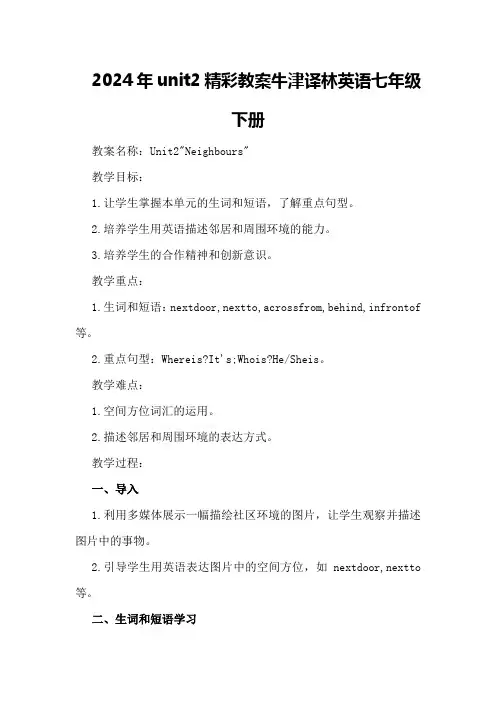
2024年unit2精彩教案牛津译林英语七年级下册教案名称:Unit2"Neighbours"教学目标:1.让学生掌握本单元的生词和短语,了解重点句型。
2.培养学生用英语描述邻居和周围环境的能力。
3.培养学生的合作精神和创新意识。
教学重点:1.生词和短语:nextdoor,nextto,acrossfrom,behind,infrontof 等。
2.重点句型:Whereis?It's;Whois?He/Sheis。
教学难点:1.空间方位词汇的运用。
2.描述邻居和周围环境的表达方式。
教学过程:一、导入1.利用多媒体展示一幅描绘社区环境的图片,让学生观察并描述图片中的事物。
2.引导学生用英语表达图片中的空间方位,如nextdoor,nextto 等。
二、生词和短语学习1.教师领读生词和短语,让学生跟读并模仿发音。
2.学生自主朗读生词和短语,巩固记忆。
3.设计一些小游戏,如“单词接龙”,让学生在游戏中复习生词。
三、重点句型学习1.教师通过演示,让学生理解Whereis?It's;Whois?He/Sheis的用法。
2.学生进行角色扮演,练习使用重点句型描述邻居和周围环境。
3.教师选取一些学生的描述,进行点评和纠正。
四、课堂活动1.分组活动:学生自由组成小组,每组选择一个社区环境,用英语描述该环境中的邻居和建筑。
2.各组展示成果,其他学生认真倾听并进行评价。
3.教师选取优秀的小组,给予表扬和奖励。
五、巩固练习1.完成课后练习题,巩固本节课所学内容。
2.学生自主编写一段描述自己社区环境的英语短文,要求运用本节课所学词汇和句型。
六、课后作业1.复习本节课所学生词和短语,熟读重点句型。
2.完成课后练习题。
3.家长签字确认,确保学生完成作业。
教学反思:本节课通过生动的图片导入,激发学生的学习兴趣。
在教学过程中,注重学生的参与和互动,让学生在轻松愉快的氛围中学习英语。
通过课堂活动和巩固练习,使学生能够熟练运用所学知识描述邻居和周围环境。
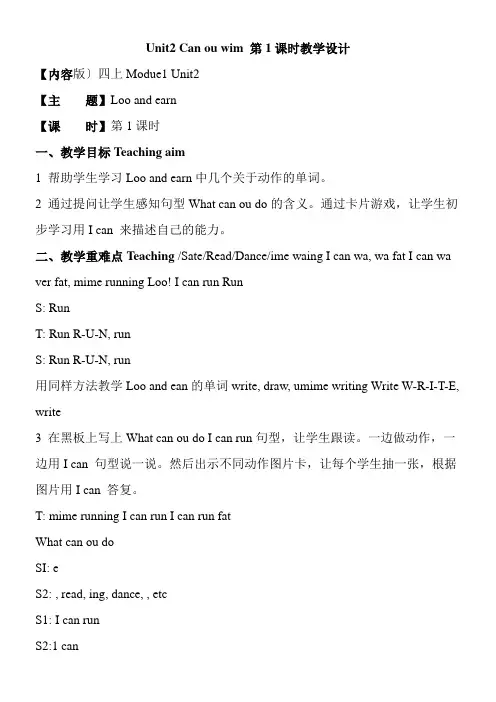
Unit2 Can ou wim 第1课时教学设计
【内容版〕四上Modue1 Unit2
【主题】Loo and earn
【课时】第1课时
一、教学目标Teaching aim
1 帮助学生学习Loo and earn中几个关于动作的单词。
2 通过提问让学生感知句型What can ou do的含义。
通过卡片游戏,让学生初步学习用I can 来描述自己的能力。
二、教学重难点Teaching /Sate/Read/Dance/ime waing I can wa, wa fat I can wa ver fat, mime running Loo! I can run Run
S: Run
T: Run R-U-N, run
S: Run R-U-N, run
用同样方法教学Loo and ean的单词write, draw, umime writing Write W-R-I-T-E, write
3 在黑板上写上What can ou do I can run句型,让学生跟读。
一边做动作,一边用I can 句型说一说。
然后出示不同动作图片卡,让每个学生抽一张,根据图片用I can 答复。
T: mime running I can run I can run fat
What can ou do
SI: e
S2: , read, ing, dance, , etc
S1: I can run
S2:1 can。
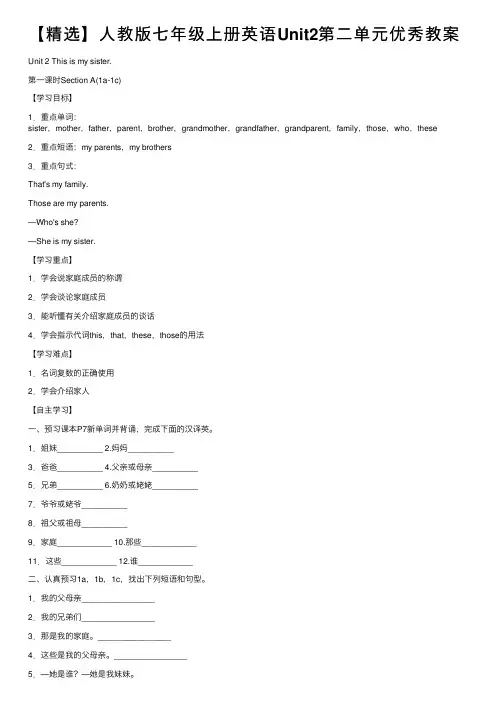
【精选】⼈教版七年级上册英语Unit2第⼆单元优秀教案Unit 2 This is my sister.第⼀课时Section A(1a-1c)【学习⽬标】1.重点单词:sister,mother,father,parent,brother,grandmother,grandfather,grandparent,family,those,who,these 2.重点短语:my parents,my brothers3.重点句式:That's my family.Those are my parents.—Who's she?—She is my sister.【学习重点】1.学会说家庭成员的称谓2.学会谈论家庭成员3.能听懂有关介绍家庭成员的谈话4.学会指⽰代词this,that,these,those的⽤法【学习难点】1.名词复数的正确使⽤2.学会介绍家⼈【⾃主学习】⼀、预习课本P7新单词并背诵,完成下⾯的汉译英。
1.姐妹__________ 2.妈妈__________3.爸爸__________ 4.⽗亲或母亲__________5.兄弟__________ 6.奶奶或姥姥__________7.爷爷或姥爷__________8.祖⽗或祖母__________9.家庭____________ 10.那些____________11.这些____________ 12.谁____________⼆、认真预习1a,1b,1c,找出下列短语和句型。
1.我的⽗母亲________________2.我的兄弟们________________3.那是我的家庭。
________________4.这些是我的⽗母亲。
________________5.—她是谁?—她是我妹妹。
_________________________________________________________________ 【课堂导学】Step 1情景导⼊Teacher:This is my family photo,and these are my family members.This is my father,and that is my mother.These are my grandparents.Can you introduce your family members to us?If you can't,don't worry.We will learn it this lesson.环节说明:由家庭照⽚引出本节课的重点——介绍家庭成员,激起了学⽣的学习兴趣,新课导⼊简单明了,过渡⾃然。

人教PEP版六年级英语上册第二单元教案Unit2Ways to go to school教学设计二、呈现(Presentatio n)1.main scene学习(1)呈现图片,仔细观察图片,回答问题,Where are they?What can you see?(2)学生仔细观察图片,展开合理想象并回答老师的问题。
Where are they?What can you see?(3)听录音,模仿朗读,理解对话内容。
①指明朗读对话,并翻译主要句子的中文意思,掌握单词、句子的读法。
2教师领读对话,学生模仿,齐读,生生对话,小组表演。
3告诉学生应该遵守交通规则,红灯停,绿灯行。
2.学习Let’s try&Let’s talk(1)T:Today I come to school on bus.Iusually come to school on foot.Whatabout you?Do you come by bike or bybus?Do you come on foot or by car?(2)Listen to the tape(3)快速反应游戏:教师说出某个短语,让学生做相应的动作并说出句子(4)听录音,跟读Let’s talk内容,注意纠正学生的发音(5)图片解释usually/often/sometimes单词的区别。
(100%80%60%40%0)(6)同桌表演对话,培养学生学习语言,课堂上激发学生不断地去说,再引入课文内容的学习。
1、free talk形式,先跟学生展开对话,让学生在学习新内容前先巩固已学过的知识。
2、通过听、游戏、动作去了解短文意思,并通过学习,引出频率副词的学习,让学生自然而然地掌握,了解所发生频率不一样,需要用不同的频率副词。
三、操练(Practice )1.Listen to the tape.Listen to the tape and read after it.2.Play a chain game教师做动作,自问自答:How doI come to school?I come to school by bike,继续重复刚才的句子并问某一位学生,继续传递下去。
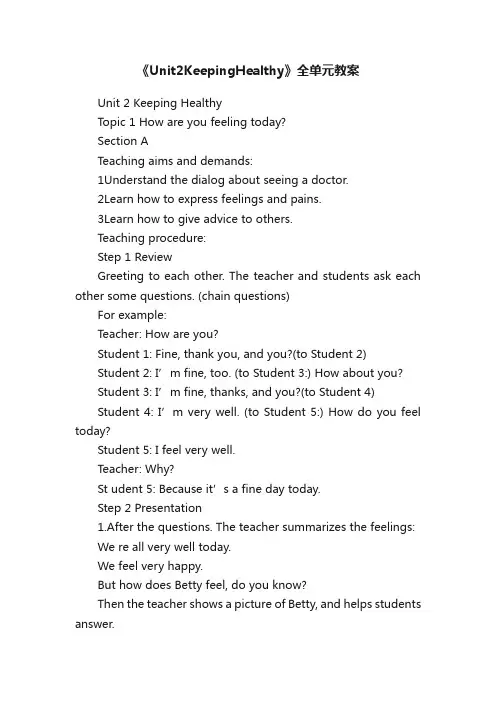
《Unit2KeepingHealthy》全单元教案Unit 2 Keeping HealthyTopic 1 How are you feeling today?Section ATeaching aims and demands:1Understand the dialog about seeing a doctor.2Learn how to express feelings and pains.3Learn how to give advice to others.Teaching procedure:Step 1 ReviewGreeting to each other. The teacher and students ask each other some questions. (chain questions)For example:Teacher: How are you?Student 1: Fine, thank you, and you?(to Student 2)Student 2: I’m fine, too. (to Student 3:) How about you?Student 3: I’m fine, thanks, and you?(to Student 4)Student 4: I’m very well. (to Student 5:) How do you feel today?Student 5: I feel very well.Teacher: Why?St udent 5: Because it’s a fine day today.Step 2 Presentation1.After the questions. The teacher summarizes the feelings:We re all very well today.We feel very happy.But how does Betty feel, do you know?Then the teacher shows a picture of Betty, and helps students answer.Play the recorder, and let students find the answers according to the listening:(1a) 2.Show some more pictures,or reading passage 2, then ask and answer: Whats the matter with him?At last, the teacher writes the key words on the blackboard and explain the new words Step 3 ConsolidationThe teacher acts as if he has a headache. Let students guess: What’s the matter with me?You have a headache.Ask the students for some advice:If I have a ..., what should I do?Then finish the exercises in 3a.Step 4 Practice1. Make a conversation in pairs.Finish 1b and 3b.For example:One student acts as if he has a toothache,another student ask him some questions. Let them make dialogs.2. Finish 4. Play the tape recorder.Let students find the correct picture and check the answer. Then play again. Let the students follow the readingStep 5 ProjectThe teacher gives the students some notes which have the phrases on them: have a headache, have a stomachache, have a toothache and so on. Let the students who gets the note act as if he has a headache. Let the other students guess and give a quick answer. Then give some advice on it.Section BTeaching aims and demands:1Go on talking about seeing a doctor.2Understand the dialogs about seeing a doctor.3Review how to give advice.Teaching procedure:Step 1 ReviewShow the pictures in last period. Let students give a quick answer. (chain questions)Teacher: What s the matter with him?Student 1:He has a toothache.Teacher: What should he do?Student 2:He should see a dentist.Change to another picture and go on with the question.Step 2 Presentation1. After showing the pictures in las t period. Show a new picture, which shows the conversation between Bruce and Mr.Lee. (or let the students have a look at 1.) Ask these questions: How does Bruce look?How does Bruce feel?Help students answer:Bruce looks pale!He doesn t feel very well!2. Play the tape recorder. Let students complete the dialog according to the listening:Mr.Lee: Hey, Bruce. You pale. What’s ?Bruce: Well. I have a and a .Mr.Lee: I’m to hear that. you have the .Bruce: DW〗Oh, I’m terrible.Mr.Lee:You’d better go to see a . Shall I you the ?Bruce: No, thank you! I’ll some medicine and see how it .Then let the students open their books, read the dialog in 1 and check th eir answers.The teacher explain the new words and language points:pale, maybe, terrible, medicineYou look pale!Shall I ...... see how it goes.Step 3 ConsolidationLet students finish 2. Make a competition. Let’s see who is the first to finish the dialog, then listen and check the answer.Make sure that the students can read the dialog correctly. Then act it out. Step 4 Practice1. Do 3. First Match the sentences. Then make up a dialog in pairs.2. Do 4.Listen and fill in the blanks. Then listen again and check the answers.Step 5 ProjectSuppose Xiao Qiang has something wrong when he is at school.(Students may have different ideas about the illnesses.) Xiao Qiang talks to Mr.Wang at Mr.Wang’soffice. Make up a dialog between Xiao Qiang and Mr.Wang. Finish the dialog during 3 to 5 minutes. And then perform in front of the class.Section CTeaching aims and demands:1Learn to Listen to some materials and get information.2Learn to use what we learned.3Learn to ask for and give advice.Teaching procedure:Step 1 ReviewGreeting each other. Play the guessing game. The teacher act out different illness es. Let students guess what it is. Ask andanswer: What’s wrong with me? You have a headache/a stomachache.What should I do?You should ...You’d better ...Step 2 PresentationThe teacher act as if his leg hurts. Then tell students: My leg hurts.Explain the new word “hurt” and ask:What happened to me? Guess!Then lead into:I had an accident, and I hurt my leg. Someone had an accident, too. Please listen to the story.Play the tape recorder,then finish 1a and 1b.After listening to the story. Let students describe the pictures according to the tape.Play again, and let students answer the questions 1b. Then check their answers.Explain the use of “hurt”Step 3 Consolidation1. The teacher asks: What should Michael do?Let the students answer first. Then listen to the dialog 2a. And finish 2b.take some medicine.Michael should stay in bed.eat a lot of fruit and drink plenty of water.Michael shouldn t move his leg too much.2. Play the tape again. Let students follow and imitate, then check their answers according to the dialog:1. F 2. F3. FStep 4 Pra ctice1. Pair work: Suppose one is a doctor, the other is a patient. Make up a dialog and act it out.2. Chain story: The teacher may give the beginning. Let the students continue with the story one by one.For example:Teacher: Yesterday Xiao Ming played basketball with his friends.Student A: Suddenly he fell down and hurt his left arm.Student B:...Step 5 ProjectHave a competition: Divide the class into groups. Each group begins a storyfrom the first student to the last. One sentence each. At last, let’s see which group has the best story in the shortest time.Section DTeaching aims and demands:1Sum up the sentence patterns and useful expressions in Topic 1.2Improve listening and speaking skills to writing skills.3Lead up suggestion voice to other topic.Teaching procedure:Step 1 ReviewAsk some questions about what they learned in the last perio d.Who had an accident?What was wrong with him?Who went to call a taxi?What was Dr.Jiang s advice to Michael?Who came to visit Michael in hospital?Let students retell the story of Michael according to thesequestions. Step 2 Presentation1. The teacher shows a letter and tell: This is a letter from Peter to Lily. But it’s not completed. Let’s help Peter to complete this letter.Let students finish 1a then read the passage loudly.Notes: 1) not... until...2) worry about ...2. The teacher asks some questions about the passage:1) Why can t Peter read the books?2) What was wrong with Peter?3) How did Peter get sick?4) How was Peter’s sister?While students are answering these questions, the teacher writes some key words on the blackboard.couldn t —until —had —weekend —a sore throat —a toothache — Friday —football — flu — sister — sick — coughed Then let the students retell the story according to the above words.Step 3 ConsolidationDo 1b. First give Peter some advice orally, then let students write down their answers. Ask some students to read their answers, then help them check the answers. Step 4 Practice1. Do 3.Put the sentences into the right blanks. Read the dialog in pairs.2. Divide the class into two groups. Think of some probl ems about health. Ask each other for help. Give some advice to solve the problem. The group which can t solve the problem will lose.Step 5 ProjectWork in groups. Four in one group. Each student goes over one section of Topic 1. Summarize the language points. At last,share with each other.Topic 2 Is it good for your health?Section ATeaching aims and demands:1.Learn to talk about the topic of the healthy living habits.2.Learn to use the gerund as the subject.3.Go on practicing how to give advice.Teaching procedure:Step 1 ReviewShow some pictures of Topic 1.Section 1, ask and answer:Teacher:What s wrong with him?Student:He has a headache.Teacher:I think he should/shouldn t...Teacher:What s the trouble with her?Student:She has a cold.Teacher:She had better(not)...Review like this.Step 2 Presentation1Teacher:Kangkang is also feeling terrible today. What s the trouble with him?Play the tape. Let students answer the questions according to listening.2Explain the new words: stay up late, health, tonight. Play again. Let students follow and imitate the reading.(1a) 3Do 1b. Students practice and act it out.Step 3 Consolidation1 Play the tape. Let students do 2.2Play again, let students follow and imitate the reading.Check the answer to “How did Wang Jun get a headache?”Step 4 Practice1Do 3: Pair work.Teacher:If I have a headache, what should I do?Student:You should/shouldn t.../You d better(not)...Then students ask and answer questions like this. (chain questions)2Teacher:Bad habits can cause headache or other illness. So we should have good hadits.Explain “habit”, then write down “habit” and “good/bad”. Students do 4a. 3Teacher:What other habits do you have?Student:I like getting up late.Teacher:Is getting up late good or bad for your health?Students:...Students work in pairs like this, finish 4b:A: Is ... good or bad for your health?B: It s good/bad....Step 5 Project1. Group work: Four students work in one group. Talk about what are healthy habits, and what are unhealthy habits. Try to use these sentences:(4b)—Is going to bed early good or bad for your health?—It’s good.Then choose one student to write down the result. And choose a speaker to give a report to the whole class.For example: We think that going to bed early is good for our health.So we should go to bed early every day.Playing sports after meals is bad for our health.So we shouldn t play sports after meals.Section BTeaching aims and demands:1Go on learning good habits to keep healthy.2Improve from “listen, read” skills to “speak, write” skills step by step.3Master “must” and “must not”.Teaching procedure:Step 1 ReviewGo on with the report on healthy habits. The teacher point out the language points:Doing sth is good/bad for ...You should do ...Step 2 Presentation1. The teacher write some habits on the blackboard.For example: eat breakfastgo out for a walkgo to bed early and get up earlydrink plenty of waterThen the teacher summarize: These are all healthy habits.But do you know why they can help us keep healthy?2. Play the tape recorder. Let the students find out the answers according to listening. (1a) First play once, if the students can not find all the answers. Play again. Then write down the key words for the answers on the blackboard:eat breakfast——gives ... energy ...go out for a walk —— good exercise ... necessary...drink plenty of water ——...good...health.go to bed early and get up early ——... keep...active... daytime.The teacher points out the new words. Make sure that thestudents can read and understand them exactly.Step 3 Consolidation1. Let students retell the passage according to the key words on the blackboard.2. Do 1b, write the vocabularies to finish the sentences.Step 4 Practice1. Do 2a. Let students speak the sentences orally:You must wash hands before meals. You must not read in strong sunlight.2. Then let students write more sentences by using “You must ...” and “You must not ...”.Step 5 Project1. Work in groups. Four students work in one group. Finish 2b. Choose one student to write down the result, and another student to give a report to the whole class.2. The students who has no chance to report should practice more after class and get ready to report in the next period.Section CTeaching aims and demands:1 Improve students’ablities from listen ing, speaking to reading.2Learn to get information from the passage by skimming.3Learn to summerize by scanning.Teaching procedure:Step 1 Review1. Let some students give a report on the project they finished in last period. The teacher points out the important sentences:You must .../You must not...2. Let the students think about the causes of the headache. And try to give some answers.Step 2 Presentation1. Play the tape recorder 1a. Let students tell “True” or “False” a bout these sentences:1)A headache is a disease.2)A headache may show that something in your body is wrong.3)We may have more than one headache each week.4)Headaches can often make you worried.5)You needn t go to see the doctor when you have a headache.The teacher can write down these sentences on flash cards before class, or he can read them after playing the tape.2. Skimming. Let students read the passage quickly and master the main idea. Underline the new words and the teacher explains them.3. Scanning. Read the passage more carefully. Then finish the questions in 1a. Step 3 ConsolidationThe teacher check the students’ answers. Then write some key words of the answers on the blackboard. Let the students retell the passage according to the key words.1)not a disease —— show —— wrong2)a fever —— other illnesses3)may get a headache whenwork —— hardcan t —— enough sleep exercise —— emptyStep 4 PracticeLet the students discuss: How does a body become sick?Then do 2a. Let students tell the ways of becoming sick:1)through the nose2)through the mouth3)through the skinStep 5 Project1. According to the result of Step 4. Let the students find out some ways to stop germs 2b. First speak some sentences orally. Make sure to use “We should .../should not...” and “We must.../must not...”.2. After the oral practice, let each of the students write at least 5 sentences about how to stop germs.Section DTeaching aims an demands:1Go on learn ing what are healthy habits.2Improve the students listening, speaking, reading and writing skills.3Summerize the grammar focus and useful expressions in the topic.Teaching procedure:Step 1 Review1. Let some students report the project in last period. The teacher point outthe language points.2. The teacher asks the students something about healthy habits.For example:—What are healthy habits?—Going to bed early is good for our health.—Doing morning exercises is a healthy habit.Step 2 Presentation1. After talking about healthy habits. The teacher asks something about healthy foods.Show some pictures and put them on the blackboard, and write the names of the foods. Make sure the students can readall of them.2. Let the students divide these foods into groups. finish 1b.3. Let students tell which are healthy foods and which are unhealthy foods.Step 3 Consolidation1. Play the tape recorder 1a. Complete the passage according to the listening.As we know, gives us energy. We must have to keep us . Of course,we must also have the of . We should eat more and andless . A cup of and an a day can help make us . Different help us in different . Too , too or a choice of can makeus .2. Play again. Let the students follow and imitate the reading.Step 4 PracticeLet the students do 3 by themselves. Then give a report to the whole class.Step 5 Project1. Let students go over all the pattern sentences in this topic 2a, 2b. Finishthe writing project 3 by using the sentences they have learned in Topic 2. Each student writes at least 5 sentences.2. Write a short passage which contains 6080 words.Title: How to Keep HealthyInstruction: Try to use the sentences you have learned in Topic 2 as many as possible.Topic 3 We should do our best to fight SARS.Section ATeaching aims and demands:1Talk about how to fight SARS.2Learn how to interview others.3Master the words “should” and “shouldn t”.Teaching procedure:Step 1 ReviewLet the students tell good habits and bad habits. Use these sentences:We should do ...We shouldn t do ...We must do ...We must not do ...We don t have to ...Step 2 Presentation1. First the teacher says to the students “Good habits can help us to keep healthy. But bad habits can cause diseases. In 2003, there was a serious disease called SARS (Severe Acute Respirators Syndrone)”. Then ask them, “what do you know about SARS?”Ask the students to talk about “SARS”.2. Introduce Kangkang s father to the students. Then the students listen to the dialog and answer the questions: —What do you know about SARS according to the listening?—It spreads easily among people.Play again, ask more questions:—What should we do to stop it?—We’d better have a balanced diet and take more exercise.—We must not go to the crowded places.Step 3 Consolidation1. Play the tape recorder, and let students follow the tape and imitate.2. Do 1b, and finish the questions in pairs.Step 4 Practice1. Let students think of more good ideas to stop SARS away from us.2. Do 2, then make up dialogs in pairs.Step 5 Project1. Make an interview: Four in one group. Suppose one of them is a journalist and the others are doctors. He asks questions, the other three answer.2. Every student writes at least three sentences about how to fight SARS.Section BTeaching aims and demands:1Learn how to make a tel ephone call.2Make sure you can take a message of a telephone call.3Make sure you can read the telephone message.Teaching procedure:Step 1 Review1. Let student retell at least three sentences about how to fight SARS.2. Ask and answer about Kankang’s father:What’s Kangkang’s father?Where is he now?Why can t he go home?Step 2 Presentation1. The teacher lead into: Kangkang misses his father very much. What should he do?The students may answer: He should call his father.2. Listen to the dialog 1a and answer questions:1)Can Kangkang’s father answ er the phone? Wh y or why not?2)What is he doing now?3)What does Kangkang tell his father?4)What will Miss Hu do?3. Play the tape again, and finish 1b.Step 3 ConsolidationLet students read 2. Put the sentences in the right order, and make up a new similar dialog.Step 4 Practice1. Read the telephone messages 1b. Complete the dialog according to the information from the messages.2. Listen to the tape. Follow and imitate.Step 5 ProjectSuppose you are calling Xiao Wang. But he’s not in. His mum answers the telephone call. You ask her to give him a message. Tell him to go to the zoo with you at 8∶30 tomorrow morning.Let students make up a dialog in pairs, then act it out.Section CTeaching aims and demands:1Learn how to do the skimming and get information.2Master the simple past tense.Teaching procedure:Step 1 Review1. Ask some questions about SARS:What do you know about SARS?What should we do to stop SARS away from us?2. Let some s tudents introduce something about Kangkang’s father.What do you know about Kangkang’s father?Step 2 Presentation1. Read the passage 1a, let students tell“True” or “False”.1)Kangkang’s father was a patient in Xiaotangshan Hospital.2)Kangkang’s fat her could talk with his family on the phone.3)SARS is a kind of serious disease.2. Read the passage more carefully. Answer the questions 1b. The teacher writes some key words on the blackboard: doctor — SARS — serious — hospital — couldn t — home — talk — phone —missed — duty — saveStep 3 Consolidation1. Using the key words on the blackboard, retell the story in 1a.2. Rewrite the story with your own words,and finish 1b.Step 4 Practice1. Listening practice: Listen to the dia log and finish the chart below:Names How did they spend their time at home? How did they think about it? Kangkang on the Internet.Michael had to and .Jane her mother at home.Maria a lot of stories at home.2. Finish 3b, 3c.Step 5 Project1. Work in groups. Four in one group. Each of the students acts one character: Kangkang, Michael, Jane and Maria. Act out the dialog according to the information in the chart.2.Work in groups. Make a survey and complete the chart below:Names How did you spend your time last Sunday? How did you think about it? 1234Choose one speaker to give a report.3.Finish 3c.Let students make up a passage ab out Kangkang’s father.Section DTeaching aims and remands:1Summerize the grammer focus and useful expressions in topic 3.2Improve the listening, speaking, reading and writing skills.3Go on talking about health.Teaching procedure:Step 1 Review1. Chain questions. Ask the students to answer the following questions quickly: Did you have breakfast this morning?What did you have for breakfast?Where do you usually have lunch?What do you have for lunch?When do you usually have supper?What do you have for supper?What is your favorite food?Which foods are good for your health?2. Ask and answer in pairs3. Then retell the answers to the class.Step 2 Presentation1. Look at the pictures 1. Describe the differences between these two pictures.2. Play the tape recorder. Choose the correct picture.3. Listen to the tape again, then write down the answers in 1. The teacher writes some key words of the answers on the blackboard.Step 3 Consoli dation1. Retell the passage according to the key words.2. Let the students go over the language points in Topic3. Do 2a, 2b.Step 4 PracticeMake a survey to each other. ( Four in one group)Complete the chart below:Names What good habits do you have? What bad habits do you have?1234Choose one speaker to give a report. Give him some advice on how to change his bad habits.Step 5 Project1Discover the information about an illness in 5. If the students can t finish it in class, give them enough time to study and find more information after class.2Using the information in T opic 3, ask the students to write a short passage on how to fight the flu.3Enjoy this song “Auld Lang Syne”。
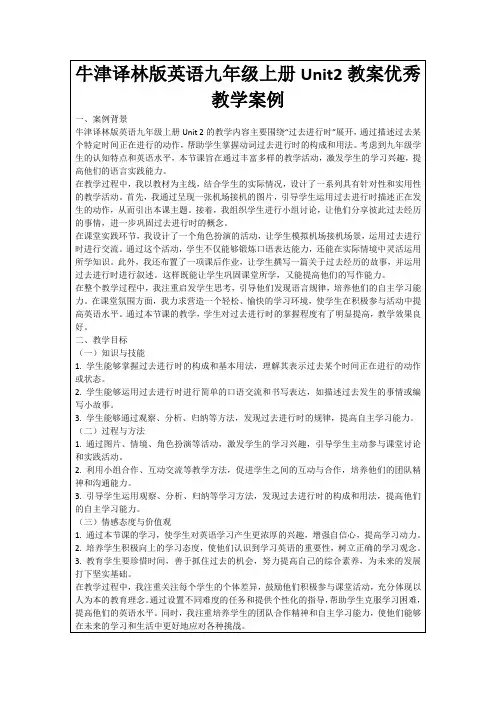
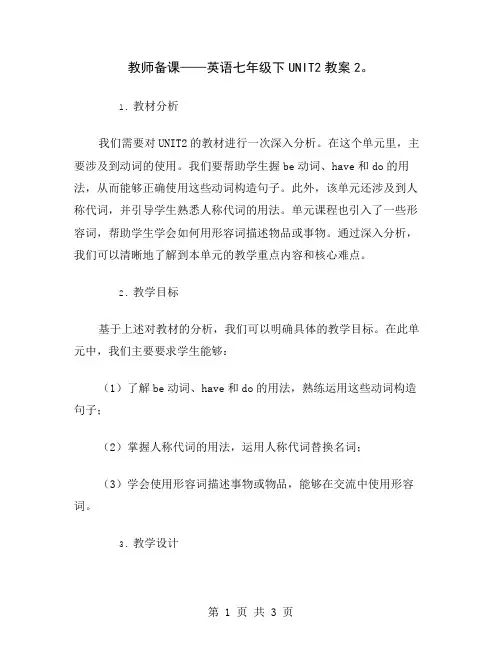
教师备课——英语七年级下UNIT2教案2。
1.教材分析我们需要对UNIT2的教材进行一次深入分析。
在这个单元里,主要涉及到动词的使用。
我们要帮助学生握be动词、have和do的用法,从而能够正确使用这些动词构造句子。
此外,该单元还涉及到人称代词,并引导学生熟悉人称代词的用法。
单元课程也引入了一些形容词,帮助学生学会如何用形容词描述物品或事物。
通过深入分析,我们可以清晰地了解到本单元的教学重点内容和核心难点。
2.教学目标基于上述对教材的分析,我们可以明确具体的教学目标。
在此单元中,我们主要要求学生能够:(1)了解be动词、have和do的用法,熟练运用这些动词构造句子;(2)掌握人称代词的用法,运用人称代词替换名词;(3)学会使用形容词描述事物或物品,能够在交流中使用形容词。
3.教学设计基于教材分析和教学目标,我们需要进行详细的教学设计。
我们可以通过提供一些生动的语言材料,向学生展示be动词、have和do 的用法。
在这个过程中,可以帮助学生发现一些常见的语言规律和用法,如肯定句、否定句和疑问句等。
同时,也可以通过练习帮助学生熟悉这些动词的使用方法。
我们可以引导学生熟悉人称代词的使用。
通过对语言材料的分析和练习,学生可以逐渐理解代词在句子中的作用和用法,并掌握有效地使用人称代词进行交际的技能。
我们可以引入形容词,让学生重点了解形容词与名词搭配方法,并且在生活实践中加强彼此搭配的印象。
在此过程中,教师要注意语言的生动性和趣味性,让学生更好地理解用法,同时,鼓励他们在交流中积极运用词汇。
4.教学评估在教学过程中,我们需要对学生的掌握情况进行评估。
在这个过程中,我们可以使用各种形式的评估方法,如听力、口语、阅读和写作等,以帮助学生全面地巩固并使用教材中的词汇和语法。
5.课后回顾最后要注意的是,教师在教学结束后,应该对教学过程进行总结和回顾,以保证学生可以更好地理解和掌握所学的内容。
在回顾过程中,可以和学生讨论一些重点难点,从而加深对其的印象,巩固所学的知识。
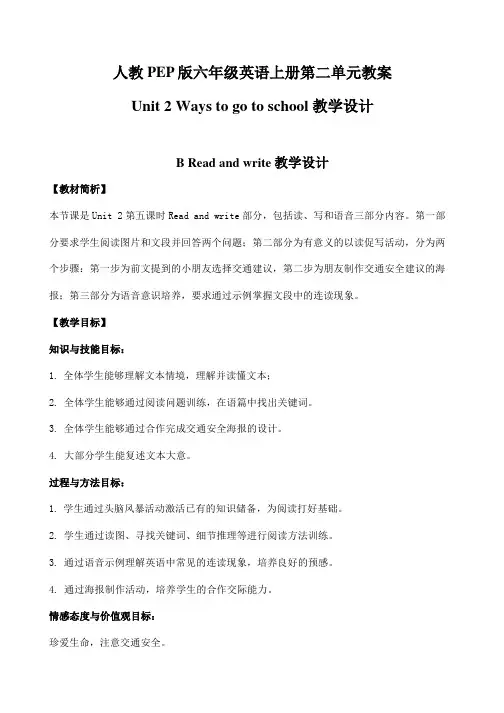
人教PEP版六年级英语上册第二单元教案Unit 2 Ways to go to school 教学设计B Read and write 教学设计【教材简析】本节课是Unit 2第五课时Read and write部分,包括读、写和语音三部分内容。
第一部分要求学生阅读图片和文段并回答两个问题;第二部分为有意义的以读促写活动,分为两个步骤:第一步为前文提到的小朋友选择交通建议,第二步为朋友制作交通安全建议的海报;第三部分为语音意识培养,要求通过示例掌握文段中的连读现象。
【教学目标】知识与技能目标:1.全体学生能够理解文本情境,理解并读懂文本;2.全体学生能够通过阅读问题训练,在语篇中找出关键词。
3.全体学生能够通过合作完成交通安全海报的设计。
4.大部分学生能复述文本大意。
过程与方法目标:1.学生通过头脑风暴活动激活已有的知识储备,为阅读打好基础。
2.学生通过读图、寻找关键词、细节推理等进行阅读方法训练。
3.通过语音示例理解英语中常见的连读现象,培养良好的预感。
4.通过海报制作活动,培养学生的合作交际能力。
情感态度与价值观目标:珍爱生命,注意交通安全。
【教学重难点】重点:1.读懂文本,了解不同地方的孩子必须因地制宜选择不同的交通方式。
2.为不同的交通方式提供对应的安全建议。
难点:1.新单词 Munich, Germany, Alaska, Papa Westray, Scotland 等。
2.根据文本内容进行细节的推理。
教具:CAIO【教学过程】I.Revision and introductionLet' s play a brain storm game. Please read as quickly as you can.【设计意图:复习学过的上学方式,激活已有的知识储备,为文本阅读做好铺垫。
】II.P resentation Pre-reading1.They are the different ways to go to school. And please look at thispicture .Who is he? What is Robin doing? What' s the passage about?That' s our topic today. (板书课题)【设计意图:呈现情境配图,引出课题。
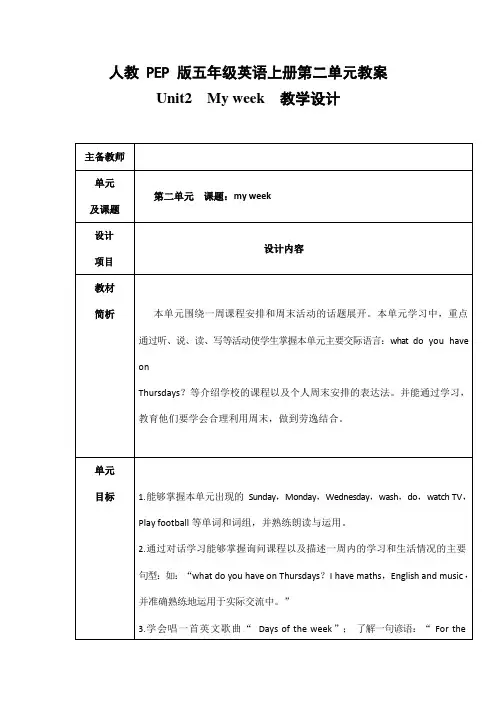
人教 PEP 版五年级英语上册第二单元教案Unit2 My week 教学设计让学生观察并思考Who are they? What are they talking about?(2).学生看图片想象并回答老师的问题。
(3).教师引导学生将讨论的结果展示交流。
(4).听录音,模仿朗读,理解对话内容。
(5)指名朗读对话,并翻译主要句子的中文意思,掌握单词、句子读法。
(6).教师领读对话,学生模仿,齐读练习,生生对话,小组表演。
2.学习let’s try let’s talk(1)listen to the .听录音,完成探究学习第一题。
(2)创设情境:让 Oliver 采访其他人。
S1:what do you have on Wednesday?S2:I have maths,English and music.随后被采访的同学去采访其他人。
最后小组练习。
习。
(3)看let’s talk 部分的课文插图,听录音,模仿朗读,理解意思。
(4)根据let’s talk 内容尝试分角色朗读对话,进行Group work,完成探究学习中二、三题。
听录音,模仿录音齐读对话听录音采访活动完成习题(3)完成探究学习中第二题的操练。
3.学习let’s spell。
(1)让刚才猜中课程表的同学来读这部分单词。
引出本课发音相近的重点单词。
(2)教师纠正该同学发音。
示范领读。
(3)让学生观察这些单词的发音规律,尤其是ea 和 ee 的发音。
(4)讲解字母组合 ee 和 ea 的发音规律。
(5)学生齐读,指名读,分小组读。
(6)完成探究学习中第三题。
(7)出示图片,讲解动词词组:read books ,feed the baby,have some beef and tea。
(8)用动词词组造句,教师给予指导。
(9)完成探究学习中第四题。
Step3 ConsolidationPlay a game:what’s missing?游戏规则:课件里出示新学的单词和词组,然后遮住其中的一个,看那个学生最先说出来。
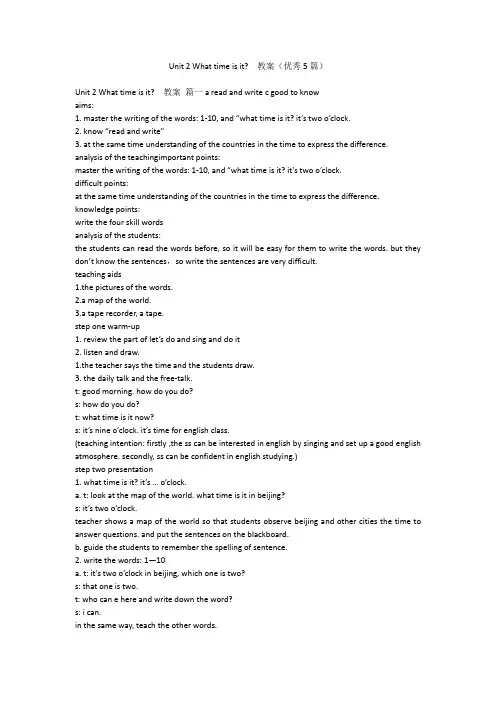
Unit 2 What time is it? 教案(优秀5篇)Unit 2 What time is it? 教案篇一a read and write c good to knowaims:1. master the writing of the words: 1-10, and “what time is it? it’s two o’clock.2. know “read and write”3. at the same time understanding of the countries in the time to express the difference. analysis of the teachingimportant points:master the writing of the words: 1-10, and “what time is it? it’s two o’clock.difficult points:at the same time understanding of the countries in the time to express the difference. knowledge points:write the four skill wordsanalysis of the students:the students can read the words before, so it will be easy for them to write the words. but they don’t know the sentences,so write the sentences are very difficult.teaching aids1.the pictures of the words.2.a map of the world.3.a tape recorder, a tape.step one warm-up1. review the part of let’s do and sing and do it2. listen and draw.1.the teacher says the time and the students draw.3. the daily talk and the free-talk.t: good morning. how do you do?s: how do you do?t: what time is it now?s: it’s nine o’clock. it’s time for english class.(teaching intention: firstly ,the ss can be interested in english by singing and set up a good english atmosphere. secondly, ss can be confident in english studying.)step two presentation1. what time is it? it’s … o’clock.a. t: look at the map of the world. what time is it in beijing?s: it’s two o’clock.teacher shows a map of the world so that students observe beijing and other cities the time to answer questions. and put the sentences on the blackboard.b. guide the students to remember the spelling of sentence.2. write the words: 1—10a. t: it’s two o’clock in beijing, which one is two?s: that one is two.t: who can e here and write down the word?s: i can.in the same way, teach the other words.b. then look at the map. then tell me, what time is it in london\ new york\ sydney?s: it’s six \ one\ four.c. listen, read and point.d. spelling the words.step three practice1. after the listening of the tape, the ss will practice the four-skilled words:pay attention to the good habits of the handwriting.(teaching intention:firstly: make the students grasp the new lesson.secondly: revise the old knowledge. )2. gameswhen the ss master the words, the teacher can use some games to practice the four-skilled words. such as: read the words quickly. pass over the words. listen and then find the words. guess the words. make a choice.(teaching intention: make the students use the new lesson . secondly: foster the students’ ability to study on their own. assess them fairly.)step four consolidation and extension1. do the wb of this part: a read and write2. know “good to know”simple on the question of the time difference, through observation of students in four different cities map at the same time as the time difference, figure out the four cities of the time difference betweendifferent cities.3. read and write cross. ( 根据实际情况,填写。
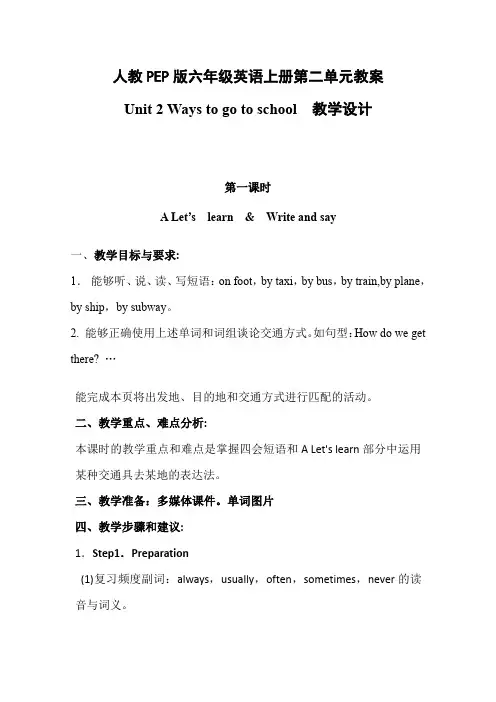
人教PEP版六年级英语上册第二单元教案Unit2Ways to go to school教学设计第一课时A Let’s learn&Write and say一、教学目标与要求:1.能够听、说、读、写短语:on foot,by taxi,by bus,by train,by plane,by ship,by subway。
2.能够正确使用上述单词和词组谈论交通方式。
如句型:How do we get there?…能完成本页将出发地、目的地和交通方式进行匹配的活动。
二、教学重点、难点分析:本课时的教学重点和难点是掌握四会短语和A Let's learn部分中运用某种交通具去某地的表达法。
三、教学准备:多媒体课件。
单词图片四、教学步骤和建议:1.Step1.Preparation(1)复习频度副词:always,usually,often,sometimes,never的读音与词义。
(2)Let's chant教师放多媒体Let's chant部分的录音,学生先静听一遍,再跟录音轻声吟唱一遍。
教师再放录音,带着学生一起边唱边做动作.Step2.Presentation1单词呈现Let's learn(1)教师拿出一辆玩具公交车,自问自答:“How do I go to school?I go to school by bike.”并在黑板上写下:by bus。
教师再重复刚才的句子并问某一学生:What about you?How do you go to school?'’学生如果回答:“Me too!”教师就继续问下一名学生,直到有不同答案,教师帮助学生说出完整的句子:“I go。
to school by…”并将相应的短语写在黑板上。
教师示范朗读,学生跟读.同法教授on foot,by taxi,by train,by plane,by ship,by subway。
【人教版】小学三年级上英语《Unit 2》优质课教案一. 教材分析本课是人教版小学三年级上册英语《Unit 2》的第一课时,主要讲述了日常生活中常见的动物名称和颜色。
本课时共有4个部分,包括听力、口语、阅读和写作。
教材内容丰富,贴近学生生活,有利于激发学生的学习兴趣。
二. 学情分析三年级的学生已经具备了一定的英语基础,掌握了基本的英语字母和单词。
他们对新鲜事物充满好奇,善于模仿,合作意识较强。
但部分学生可能对英语学习仍存在恐惧心理,需要教师多给予鼓励和关爱。
三. 教学目标1.知识目标:学生能够听懂、会说、会读本课的生词和句子,掌握动物名称和颜色词汇。
2.能力目标:学生能够运用所学知识进行简单的日常交流,提高口语表达能力。
3.情感目标:培养学生热爱生活、关爱动物的情感。
四. 教学重难点1.重点:学生能够正确说出动物名称和颜色词汇。
2.难点:学生能够熟练运用所学知识进行日常交流。
五. 教学方法采用情景教学法、游戏教学法和分组合作教学法,激发学生的学习兴趣,提高学生的参与度。
六. 教学准备1.教师准备:准备好教材、课件、卡片、动物玩具等教学用品。
2.学生准备:提前预习教材,熟悉本课内容。
七. 教学过程1.导入(5分钟)教师通过播放英文歌曲《Old MacDonald Had a Farm》引导学生进入学习状态,激发学生对动物的兴趣。
2.呈现(10分钟)教师展示教材中的插图,引导学生说出图片中的动物和颜色。
教师出示卡片,让学生模仿发音,纠正发音错误。
3.操练(10分钟)教师学生进行小组活动,让学生互相提问动物和颜色,如:“What’s this? It’sa/an… What color is it?”学生用所学词汇进行回答。
4.巩固(5分钟)教师邀请学生上台展示自己的口语表达能力,其他学生进行评价。
教师给予鼓励和指导。
5.拓展(5分钟)教师引导学生发挥想象,用自己的语言描述一种喜欢的动物和颜色,学生互相分享。
Unit2 Going to choo第一课时一、教学重点本课时的教学重点:词汇:b bie, b bu, b car, on foot, wa, far from句型:How do ou come to choo I come to coo on foot教学栏目:Liten and aLoo and earn教学目标:1、帮助学生学习Loo and earn中的生词。
2、通过Liten and a的情景对话,帮助学生掌握句型How do ou come to choo I come to教学难点:本课时的教学难点是如何利用所提供的对话和情景,以旧引新,让学生进入学习状态。
三、课前准备1、教师准备教学过程中所需要的图片、声音、课件,以及本课时的单词卡。
2、准备一些照片或图片。
四、教学过程:一、Pre-ta rearation1、学生欣赏并轻声跟唱歌曲Thi i the wa2、教师用生词图片卡或多媒体出示各种交通工具,学生跟着教师一起做动作边诵读儿歌。
二、Whie-ta rocedure1、展示各种交通工具的图片,看图说话,教授核心句型及词汇。
2、学生听课文录音,回答相关问题。
3、学生在教师指导下阅读课文,完成下面的表格,再完成后续练习。
4、学生分角表演课文。
然后开展小组活动,在小组中分角表演对话。
三、Pot-ta activitie1、出示学生熟悉的不同场所的图片,让学生在真实的语境下,操练所学句型。
2、学生准备一些卡片,进行句型操练。
在一组卡片上写下目的地(如超市,图书馆,公园),另一组卡片上写上交通工具,安排学生分别抽取目的地和交通工具的卡片,然后师生问答。
四年级下册英语教案- Unit 2 There are forty students inour class Lesson 9 人教精通版一、教学目标1.能够听、说、读、写本课时的新词汇和句型。
2.能够掌握在询问班级人数时的正确的表达方式,如:How many students are there in your class? There are forty students in our class.3.学生能够在情境中运用所学词汇和句型,进行日常交际和表达。
二、教学重点和难点教学重点1.能够听、说、读、写本课时的新词汇和句型。
2.能够掌握在询问班级人数时的正确的表达方式,如:How many students are there in your class? There are forty students in our class。
教学难点能够在情境中运用所学词汇和句型,进行日常交际和表达。
三、教学准备1.教师准备课件、多媒体设备等。
2.教师准备小样板,带班教师或学生代表向班级匿名调查班级人数。
四、教学流程Step 1 导入新课1.利用多媒体设备播放一段视频,引出新的主题 Unit 2 There are forty students in our class.2.利用课件,出示本单元目标并复习上节课中所学内容。
Step 2 自我介绍1.教师介绍自己,讲述自己的爱好、家人等基本情况,以此为例,给学生一个认识教师的机会。
2.鼓励学生相互介绍,以此为例,加强学生之间的集体感。
Step 3 学习新词汇和句型1.教师利用课件出示生词表,通过图片或单词解释等方式,学习本单元新词汇、短语。
2.教师出示对话,示范问询班级人数的正确表达方式。
3.请学生模仿示范,进行问询班级人数的情景对话练习。
Step 4 小组活动1.教师将学生分成若干个小组。
2.每个小组均需由一名代表或班主任向班级匿名调查班级人数,并记录在小样板上。
◆内容分析【What】本板块话题为科学爱好者,语篇是Millie介绍朋友Daniel的兴趣爱好的文章,首段介绍了Daniel是科学爱好者,并提出了Daniel认为科学就在我们身边,改变了我们的生活的观点;第二、三、四段分别描述了Daniel热爱科学的具体行为表现,即参观科学博物馆、拆卸物品并研究原理、阅读科学书籍以及网络检索科学问题的答案;第五段介绍了Daniel的梦想是成为科学家,并对他的梦想给予肯定和支持。
文本内容符合推进科学教育发展的要求,体现出鲜明的时代性。
【Why】本文通过描述Daniel对科学的热爱及他热爱科学的具体表现,启发学生思考何为“爱好”,并关注身边无处不在的科学,引导学生认识到良好的兴趣爱好对于人的积极影响及未来职业选择的影响,为青少年培养有益的兴趣爱好奠定良好的基础。
【How】本文的语篇类型是人物描写,文章结构清晰且包含了阐述爱好活动的主题词汇,如visit science museums、take things apart、learn how they work、go on the internet、find answers to his questions等,以及阐述爱好活动及其相关理想的语言表达,如“He gets to ...”“He likes to ...”“Now he can ...”“He wants to be ...”等。
此外,文章使用very、often等副词,cool、endless等形容词,all kinds of等短语以及感叹号来表现Daniel对科学的热爱,极大地增强了感染力,调动了读者的情绪;全文采用了一般现在时,体现了Daniel探索科学的具体活动已成为规律性、习惯性行为,是目前的真实情况,增强了文本的真实性。
◆教学目标通过本课时学习,学生能够:1. 借助可视化图形获取语篇结构并梳理事实信息,即Daniel兴趣爱好的成因、具体表现及产生的影响、他的科学梦想(学习理解);2. 分析“爱好”的具体内涵以及;判断同学对丹尼尔实现梦想持积极态度的原因(应用实践);3. 通过流程图描述自己的兴趣爱好,分析“爱好”重要的原因(迁移创新)。
Unit 2 This is my sister.一、单元教材分析本单元围绕―家庭成员‖这一主题展开听、说、读、写等多种教学活动。
教学核心是用英语介绍家人和朋友,通过本单元的学习学生应该掌握对家庭成员的称呼;通过谈论―家庭‖的话题,使学生学会并掌握―介绍人物、识别人物‖的基本句型,进一步体会一般疑问句的用法,学会运用指示代词介绍人物,学会运用人称代词询问人物。
如:This is my sister。
Is that your brother? These are my parents。
Are those your brothers? 以及Who开头的特殊疑问句,一般疑问及其简单回答;运用名词的复数形式。
能够用英语向朋友介绍自己的家人,从而让他们了解自己的家庭。
二、单元学情分析从教材编排上说本单元是就第一单元认识朋友之后,仍接着学习用英语认知人,而与学生最为熟悉的人就是家庭成员,由了解同学们的名字很自然过度到了解对家庭成员的名字,以及对家庭成员的称呼,对学生们来说比较容易接受。
以前学的your, his, her, my等形容词性物主代词,在本单元中扔是重点学习的任务;但在本单元要接触名词的复数形式,以及be动词的复数形式,且本单元生词较多,因此本单元的学习任务比较艰巨。
三、单元教学建议本单元的学习应通过对人物个性化的描述,识别照片、图片,多媒体展示、真实情景表演等学习策略来掌握家庭成员的表达;学会指示代词、人称代词及Who问句及简单回答。
为学生创设真实的学习情景,让学生以小组形式交流学习,并在课堂上循环训练。
通过介绍家人和了解朋友的家人,增进彼此的了解,建立友谊,从而更好地尊重对方,理解家人。
四、单元课时分配本单元可用4课时完成教学任务:Section A1 (1a-2d) 用1课时Section A2 (Grammar Focus-3c) 用1课时Section B1 (1a-2c) 用1课时Section B2 (3a-Self Check) 用1课时Section A1 (1a-2d)一、教学目标:1. 语言知识目标:1) 能掌握对家庭成员的称呼的词汇及指示代词:sister, father, mother, grandfather, grandmother, brother, parent (s), grandparent (s), who, they, this, that, these, those 2)能掌握以下句型:①—This/That is his sister.②—These/Those are his parents.③—Who's she? —She's my s ister.④—Is this/that your sister? —Yes, she is./No, she isn't.⑤—Are these/those your parents? —Yes, they are./No, they aren't.3) 掌握指示代词this, that, these, those及它们所构成的介绍他人的句型。
New Horizon College EnglishNew Horizon College EnglishUnit 1Section AI.Lead-in1.How do you understand the two following quotations?1)There is no friendship, no love, like that of the parent for the child.— Henry Ward Beecher2) While we try to teach our children all about life, our children teach us what lifeis all about.— Angela Schwindt 2.Survey: How close are you and your parents?To what extent are you close to your parents?3.Watch some videos and discuss the questions below:1)What happened to the father and the son?2)Is there any conflict or disagreement between you and your parents? Andwhat should we do to settle the conflict or disagreement?II.Text StructurePart I (para.1-3)The daughter is leaving home for independence and the mother feels glad on the one hand and expresses her concern / doubt on the other.Part 2 (Para.4-7)The daughter leaves a mess in her rooms and the mother straightens up the rooms.Part 3 (Para.8) After the mother finds a large envelope with all the memorable things the parents gave to the daughter, the mother’s attitude changes/reverses completely.III. Detailed Study1. Words in Using1)awaitvt. 1 wait for sth. 等待;等候e.g. The little boy was still awaiting his father’s return when the clock struck 11.当时钟敲响11 点时,那个小男孩仍在等着他爸爸回来。
2 if sth. awaits you, it will happen to you (某事)将降临到…身上e.g. The biggest surprise awaiting the birthday girl is that her father is flying toLondon for her birthday.那个过生日的女孩即将得到的最大惊喜是她爸爸将飞到伦敦来为她庆祝生日。
2)embarrassmentn. 1 [C] sb. or sth. that causes problems or makes you feel ashamed 让人难堪的人;使人为难的事e.g. He is such an embarrassment to his family. 他让他的家人感到非常难堪。
2 [U] a feeling of being nervous or ashamed because of what people know orthink about you 尴尬;难堪;窘迫e.g. To her terrible embarrassment, there were many people around when one ofher high heels broke off.她一只高跟鞋的鞋跟断了,当时周围有许多人,这让她很尴尬。
3)polishn. [C, U] a chemical substance that you rub onto an object to make it shine 上光剂;擦光剂e.g. The girl was told by her parents to remove the polish from her nails becauseshe was too young for make-up.女孩的父母让她把指甲油擦掉,因为她还太小,不适合化妆。
vt. 1 make sth. smooth, bright, and shiny by rubbing it 擦亮;擦光e.g. He polished his glasses with a handkerchief in order to see more clearly.他用手帕擦了擦眼镜,以便看得更清楚些。
2 improve a piece of writing, a speech, etc. by making slight changes to it beforeit is completely finished 修改;润色e.g. Your essay is good; you just need to polish it a bit.你的文章不错,你只要稍加润色就可以了。
4)comicn. [C] (also ~ book) a magazine for children that contains stories told in a seriesof drawings (儿童)连环漫画册e.g. With the combination of pictures and texts, comics are a good way to getchildren to begin their adventures in reading.连环漫画册图文并茂是让儿童开始接触阅读的一个好办法。
a. amusing you and making you want to laugh 滑稽的;好笑的e.g. Even the misfortune in his personal life was used by him in creating hiscomic movies.连他生活中的不幸遭遇也被他用于创作喜剧电影。
5) clumsya. 1 not easy to use and often large and heavy (物体)笨重的e.g. The first mobile phones were heavy and clumsy to use, but nowadays theyare much easier to handle.第一代手机用起来很笨重,不过如今的手机用起来方便多了。
2 moving in an awkward way and tending to make things fall over 笨拙的;不灵活的e.g. When people get drunk, they become clumsy and cannot speak clearly.人们喝醉后会变得行动笨拙,说话含糊。
6) curlv. form a twisted or curved shape, or make sth. do this 盘绕;缠绕e.g. It seems to me that the best way to relax is to curl up in the sofa with a cup oftea, and watch TV.对我而言,最好的放松方法就是泡上一杯茶,蜷在沙发上看电视。
7) strainvi. pull hard at sth. or push hard against sth. 使劲拉;使劲推;绷紧e.g. The dog strains at the rope fastened to its collar, eager to be off.那只狗使劲拽着拴在脖子上的绳子,拼命要挣脱。
vt. injure a muscle or part of your body by using it too much or making it work too hard 拉伤;扭伤;损伤e.g. I strained a muscle in my back when playing tennis.我在打网球时拉伤了背上的一块肌肉。
n.[C, U] worry that is caused by having to deal with a problem or work too hard over a long period of time 焦虑;紧张e.g. We know that a long time without change can lead to boredom, and physicaland mental strain.我们知道,长时间没有变化会导致乏味,以及身体和精神上的紧张。
8) curbn. [C] (BrE kerb) the raised edge of a road, between where people can walk and cars can drive 路缘e.g. For the sake of safety, please walk as close to the curb as possible. 为了安全起见,请尽量靠近路缘走路。
vt. control or limit sth. in order to prevent it from having a harmful effect 控制;抑制;约束e.g. The government should take steps to curb the rapid rise in housing prices.政府应采取措施抑制房价的快速上涨。
9) stripvt. (also ~ off)1 remove sth. that is covering the surface of sth. else 剥去;除去e.g. She asked us to strip off the sheets and bring them downstairs when we leave.她叫我们离开时把床单撤下来并带到楼下。